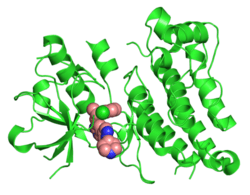What function does ALK serve in a healthy human? Read on for some fascinating proposed hypotheses.
We all know that a faulty ALK activation domain leads to all kinds of trouble. But what is the normal function of the ALK protein?

ALK was identified in 1997 by two groups, Iwahara et. al. and Morris et al, to be a receptor tyrosine kinase (RTK) of 1,620 amino acids. An RTK usually sits on the cell membrane to receive external signals and transfer the information inside the cell for action. This protein is conserved because orthologs (very similar proteins with a common ancestral gene) have been found in lower organisms such as fruit flies, nematodes, zebra fish, and mice. There are many different ALKs – ALK1 to ALK6. Each ALK member forms a unique complex that is different from others.
But what activates ALK? Originally, ALK was implicated in the determination of the nervous system where ALK expression is mostly observed. If a scientist knocked out the ALK gene (i.e. made it non- functional) in a mouse model, the animal would still survive, indicating that the ALK gene is not essential for survival, however there would be subtle behavioral abnormalities. For a while, ALK was considered as the “longevity gene” because it elongated the lifespan of a female fruit fly
Additionally, ALK has been proposed to be the “thinness gene” because an ALK-mutant mouse could not be induced to gain weight by being fed a weight gaining diet. However, it has most recently been implicated in LDL (low-density lipoprotein) uptake. This is fascinating because numerous patients in our group taking Lorlatinib have reported dramatic cholesterol increases.
While we are unsure of the exact function of ALK, we do know what it does if ALK has been truncated to only encompass the tyrosine kinase domain – aberrant ALK function leads to tumor development.

The downstream function of ALK has been studied extensively. The activated ALK gene will dimerize (link with another ALK), then phosphorylate (add a phosphate) to other receptors in close contact with the ALK complex. This leads to a cascading event where ALK will activate multiple downstream signal pathways, including MAPK-ERK (cell cycle & proliferation /cancer), PI3K-AKT(proliferation/cancer), PLCCa+ regulation + MAPK-ERK), CRKL-C3G (adhesion & migration) , and JAK-STAT (immune response, cell dying by apoptosis/cancer). Each signal is determined by the partner protein which the ALK complex binds to.
https://en.wikipedia.org/wiki/Anaplastic_lymphoma_kinase
https://www.sinobiological.com/resource/alk-1/proteins
Author: Alice Chou



